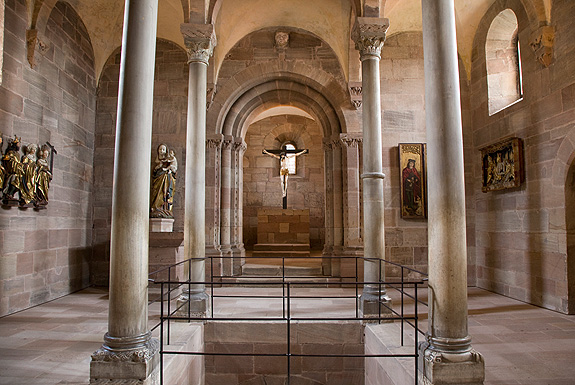Imperial Castle > Palas with exhibition »Emperor – Empire – City« and double chapel > Imperial Chapel
Main information:
Imperial Castle of Nuremberg
Palas with exhibition »Emperor – Empire – City« and double chapel

Imperial Chapel
The part of the castle that is most important from a historical and artistic point of view is the Hohenstaufen double chapel with the emperor’s gallery. The building, but not the interior appointments, which had been stored elsewhere, survived the Second World War almost unscathed.
A double chapel typically consists of two chapels with the same ground plan one above the other, which can be connected through an opening in the middle so that the congregation in either chapel can at least hear the service in the other one.
The upper part of the double chapel, the so-called Imperial Chapel, has very unusual proportions for the Romanesque period. From the Palas the visitor leaves the gallery with its low vault and sturdy columns and enters a lofty, light-filled church interior supported by four remarkably slender limestone columns with the texture of marble. The altar shrines of the Imperial Chapel have not been preserved. In the place where the high altar originally stood there is now a wooden carving of Christ on the Cross – probably by the famous Nuremberg artist Veit Stoß.
The emperor’s gallery – a unique feature of the Nuremberg double chapel – permitted the emperor to remain at a distance from the court, and was taken a step further in 1520 with the installation of a heatable oratory for Emperor Charles V in the south bay of the gallery. The emperor’s gallery also cleverly raises the chapel to the level of the upper hall, enabling it to be accessed from the adjoining imperial apartments.


Facebook Instagram YouTube